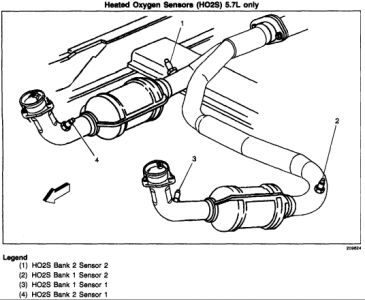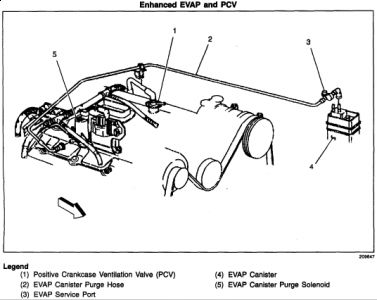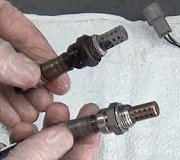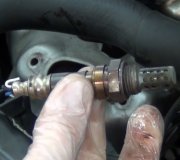If after replacement of sensors and the problem recurrs, the next thing to do would be to check the wirings. Here are the diagnostic procedures.
DTC P0137: HO2S CIRCUIT-LOW VOLTAGE-BANK 1, SENSOR 2 (4.8L, 5.3L & 6.0L "C" & "K" SERIES & 5.7L "F" & "Y" BODIES)
Circuit Description
PCM supplies about 450 millivolts (mV) between HO2S high and low signal circuits. The HO2S voltage ranges from about 1000 mV when exhaust is rich to about 10 mV when exhaust is lean. PCM monitors and stores sensor voltage information and evaluates voltage samples to determine amount of time sensor voltage is out of range. If PCM detects HO2S voltage is less than predetermined voltage, DTC P0137 will set.
For duplication of DTC, ensure:
"� DTCs P0101, P0102, P0103, P0112, P0113, P0117, P0118, P0121, P0122, P0123, P0125, P0200, P0335, P0336, P0351-P0358 or P1258 are not set.
"� AIR, EGR and catalyst diagnostics not active.
"� Ignition voltage is greater than 9 volts.
"� Fuel system is operating in "closed loop".
"� Fuel trim learn is enabled.
"� TP sensor angle is between 2 and 70 percent.
Diagnostic Procedures
1. Perform On-Board Diagnostic (OBD) system check.
After performing OBD system check, go to next
step.
2. Start and warm engine to normal operating temperature. Operate vehicle under conditions equired to set DTC. Using scan tool, select ENGINE 1 DATA LIST and monitor HO2S voltage. If HO2S 2 voltage is fixed less than 80 mV, go to step 4. If HO2S voltage is not fixed less than 80 mV, go to next step.
3. Turn ignition on, with engine off. Using scan tool, review FREEZE FRAME and/or FAILURE RECORDS data and note parameters. Turn ignition off for about 15 seconds. Start engine and operate vehicle within conditions required for this diagnostic to run, and as
close to conditions recorded in FREEZE FRAME/FAILURE RECORDS as possible. Select DTC function, and then enter DTC P0137. If scan tool indicates that this test failed this ignition, go to next step. If scan tool does not indicate that this test failed this ignition, see DIAGNOSTIC AIDS.
4. Disconnect HO2S 2 connector. Connect a fused jumper wire between PCM connector (harness side), HO2S 2 low circuit and ground. If sensor voltage is 350-550 mV, see DIAGNOSTIC AIDS. If sensor voltage is not 350-550 mV, go to next step.
5. Turn ignition off. Disconnect PCM harness connector C1. Check HO2S 2 signal circuit for short to ground or short to sensor ground circuit. Repair as necessary. After repairs, go to next step. If circuit(s) are okay, go to step 7.
6. Repair HO2S 2 signal circuit. After repairs, go to step 8.
7. Replace PCM. Program replacement PCM using required equipment. After repairs, go to next step.
8. Using scan tool, clear DTCs. Start and warm engine to normal operating temperature. Select
DTC, SPECIFIC, and then enter DTC P0137. Operate vehicle within conditions for setting this DTC. If scan tool indicates that this test ran and passed, go to next step. If scan tool does not indicate that this test ran and passed, go to step 2.
9. Using scan tool, select CAPTURE INFO, REVIEW INFO function. If any undiagnosed DTCs are displayed, go to applicable DTC test. If no undiagnosed DTCs are displayed, system is okay.
Diagnostic Aids
Check HO2S pigtail wire for breaks, contamination or grounding on exhaust manifold. Check for intermittent ground in signal wire between sensor connector and sensor.
Check for lean injector(s). Perform injector balance test. See appropriate SYSTEM & COMPONENT TESTING article. Check for fuel contamination, improper fuel pressure or exhaust leak, especially near HO2S. Check for vacuum or crankcase leak, causing a lean condition.
DTC P0140: HO2S CIRCUIT-INSUFFICIENT ACTIVITY-BANK 1, SENSOR 2 (4.3L, 5.0L, 5.7L & 7.4L "C", "G", "K" & "P" SERIES)
Circuit Description
VCM supplies a voltage of about.45 volt between HO2S 2 signal and HO2S 2 ground circuits. HO2S 2 varies voltage from about one volt with rich exhaust to.1 volt with lean exhaust. HO2S 2 produces no voltage and acts as an open circuit when temperature is less than 600 °F (316 °C). An open sensor circuit or a cold sensor causes open loop operation.
HO2S 2 heater provides for faster sensor warm-up allowing sensor to become active in a shorter period of time and remain active during long extended idle. DTC determines if HO2S 2 or HO2S 2 circuit is open. DTC P0140 will set if VCM fails to detect minimum number of HO2S 2 voltage transitions greater than and less than bias voltage range of 300-600 mV.
For duplication of DTC, ensure:
"� No active EVAP system, misfire, TP, IAT, MAP, ECT or MAF sensor DTCs are set.
"� No intrusive tests are in progress.
"� No device controls are active.
"� System voltage is 11.7-18 volts.
"� Engine run time is greater than 2 minutes.
"� Decel fuel cut-off mode is not active.
"� ECT is 137 °F (58.5 °C) or greater.
"� MAF is 13 grams per second.
"� System is in closed loop.
Diagnostic Procedures
1. Perform On-Board Diagnostic (OBD) system check. After performing OBD system check, go to next
step.
2. Using scan tool, store DTC information from VCM. Clear DTCs and reset fuel trim values. Start engine and allow it to reach normal operating temperature. Monitor HO2S 2 voltage on scan tool. If voltage is fixed at 400-473 mV, go to step 4. If voltage is not as specified, go to next step.
3. Condition that set DTC is not present at this time. If any additional DTCs are set, go to applicable DTC test. If no additional DTCs are set, see DIAGNOSTIC AIDS.
4. Turn ignition off. Disconnect HO2S 2 harness connector. Using jumper wires, jumper HO2S 2 high and low signal circuits to ground. Turn ignition on. Monitor HO2S 2 voltage with scan tool. If voltage is less than 20 mV, go to step 7. If voltage is not less than 20 mV, go to next step.
5. Turn ignition off. Remove jumper wires. Disconnect VCM harness connector containing HO2S 2 circuits. Measure resistance of HO2S 2 high and low signal circuits between HO2S 2 and VCM. If resistance of both circuits is less than 5 ohms, go to next step. If resistance of either circuit is not less than 5 ohms, go to step 9.
6. Check VCM harness connections. Repair as necessary. After repairs, go to step 17. If connections are okay, go to step 16.
7. Remove jumper wires from HO2S 2. Turn ignition on. Connect test light between HO2S 2 heater ignition feed and ground circuits at HO2S 2 harness connector. If test light illuminates, go to next step. If test light does not illuminate, go to step 10.
8. Turn ignition off. Reconnect HO2S 2 harness connector. Disconnect VCM harness connector containing HO2S 2 low signal circuit and VCM harness connector containing VCM ground circuits. Measure resistance between HO2S 2 low signal circuit and one of the VCM ground circuit terminals at VCM harness connector. If resistance is less than 500
ohms, go to step 12. If resistance is not less than 500 ohms, go to step 11.
9. Repair circuit with high resistance. After repairs, go to step 17.
10. Repair HO2S 2 heater ignition feed or ground circuit. After repairs, go to step 17.
11. Repair high resistance between HO2S 2 low signal circuit and VCM ground circuit. After repairs, go to step 17.
12. Check for exhaust leaks upstream of HO2S 2. Repair as necessary. After repairs, go to step 17. If no leaks are found, go to next step.
13. Allow engine to completely cool. Measure resistance between HO2S 2 low signal circuit and one of the VCM ground circuit terminals at VCM harness connector. If resistance is less than 500 ohms, go to step 15. If resistance is not less than 500 ohms, go to next step.
14. Remove HO2S 2. Clean threads and apply anti-seize compound, and then reinstall. Measure resistance between HO2S 2 low signal circuit and one of the VCM ground circuit terminals at VCM harness connector. If resistance is less than 500 ohms, go to step 17. If resistance is not less than 500 ohms, go to next step.
15. Replace HO2S 2. After repairs, go to step 17.
16. Replace VCM. Program replacement VCM using required equipment. Perform Passlock � reprogramming and CKP system variation learn procedures. After repairs, go to next step.
17. Using scan tool, clear DTCs. Start engine and operate vehicle under conditions required to set this DTC. If scan tool indicates this test ran and passed, go to next step. If scan tool does not indicate this test ran and passed, go to step 2.
18. Using scan tool, select CAPTURE INFO, REVIEW INFO function. If any undiagnosed DTCs are displayed, go to applicable DTC test. If no undiagnosed DTCs are displayed, system is okay.
Diagnostic Aids
An intermittent may be caused by a poor connection, rubbed-through wire insulation or a broken wire inside insulation. Inspect harness connectors for backed-out terminals, improper mating, broken locks, improperly formed or damaged terminals, poor terminal-to-wire connection, and
damaged harness.
With ignition on and engine off, HO2S 2 voltage on scan tool should gradually decrease to less than.15 volt indicating heater is operating properly. If voltage does not decrease as specified, disconnect HO2S 2 connector and connect a test light between HO2S 2 connector terminals "C" and "D" (engine harness side). If test light illuminates, replace HO2S 2. If test light does not illuminate, repair open in HO2S 2 heater ground circuit or HO2S 2 ignition feed circuit.
Using scan tool, monitor signal voltage while wiggling O2S 2 related connectors and wiring harness with a warm engine running at part throttle in closed loop. If a failure is induced, signal voltage will change from normal fluctuating voltage of greater than.6 volt and less than.3 volt, to a fixed voltage of about.45 volt. A change in voltage will assist in isolating location of fault. DO NOT solder HO2S wires.
Thursday, February 7th, 2019 AT 7:23 PM
(Merged)







